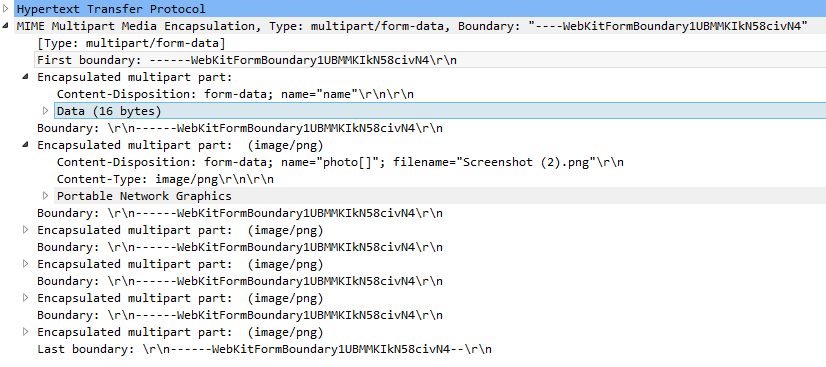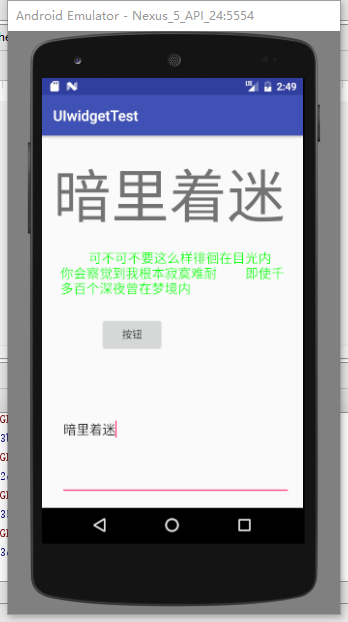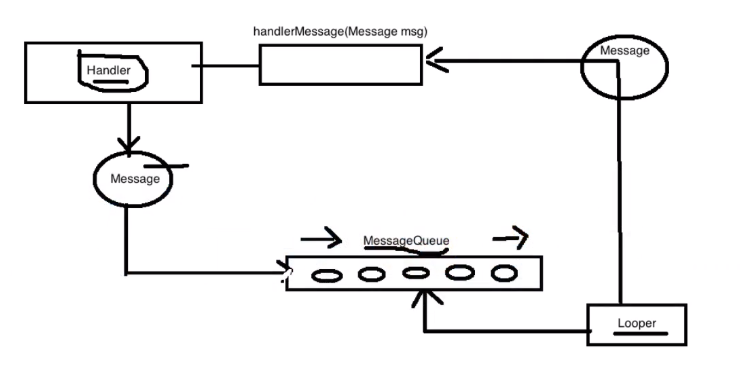編輯:關於android開發
使用浏覽器上傳文件,然後通過Wireshark抓包分析,發現發送的數據大概是這個樣子。

MIME Multipart Media Encapsulation, Type: multipart/form-data, Boundary: "----WebKitFormBoundary1UBMMKIkN58civN4"
[Type: multipart/form-data]
First boundary: ------WebKitFormBoundary1UBMMKIkN58civN4\r\n
Encapsulated multipart part:
Content-Disposition: form-data; name="name"\r\n\r\n
Data (16 bytes)
Boundary: \r\n------WebKitFormBoundary1UBMMKIkN58civN4\r\n
Encapsulated multipart part: (image/png)
Content-Disposition: form-data; name="photo[]"; filename="Screenshot (2).png"\r\n
Content-Type: image/png\r\n\r\n
Portable Network Graphics
Boundary: \r\n------WebKitFormBoundary1UBMMKIkN58civN4\r\n
Encapsulated multipart part: (image/png)
Boundary: \r\n------WebKitFormBoundary1UBMMKIkN58civN4\r\n
Encapsulated multipart part: (image/png)
Boundary: \r\n------WebKitFormBoundary1UBMMKIkN58civN4\r\n
Encapsulated multipart part: (image/png)
Boundary: \r\n------WebKitFormBoundary1UBMMKIkN58civN4\r\n
Encapsulated multipart part: (image/png)
Last boundary: \r\n------WebKitFormBoundary1UBMMKIkN58civN4--\r\n
首先來自定義一個HttpEntity,
package cc.dewdrop.volleydemo.utils;
import com.android.volley.VolleyLog;
import org.apache.http.Header;
import org.apache.http.HttpEntity;
import org.apache.http.message.BasicHeader;
import java.io.ByteArrayInputStream;
import java.io.ByteArrayOutputStream;
import java.io.Closeable;
import java.io.File;
import java.io.FileInputStream;
import java.io.FileNotFoundException;
import java.io.IOException;
import java.io.InputStream;
import java.io.OutputStream;
import javax.activation.MimetypesFileTypeMap;
/**
* Created by Tingkuo on 12/1/2015.
*/
public class FileUploadEntity implements HttpEntity {
private static final String TAG = FileUploadEntity.class.getSimpleName();
private static final String BOUNDARY = "__FILE_UPLOAD_ENTITY__";
private ByteArrayOutputStream mOutputStream;
public FileUploadEntity() {
mOutputStream = new ByteArrayOutputStream();
try {
writeFirstBoundary();
} catch (IOException e) {
e.printStackTrace();
}
}
private void writeFirstBoundary() throws IOException {
VolleyLog.e("writeFirstBoundary");
mOutputStream.write(("--" + BOUNDARY + "\r\n").getBytes());
mOutputStream.write(("Content-Disposition: form-data; name=\"" + "name" + "\"\r\n\r\n").getBytes());
mOutputStream.write("Content-Transfer-Encoding: binary\n\n".getBytes());
mOutputStream.flush();
}
private void writeLastBoundary() throws IOException {
VolleyLog.e("writeLastBoundary");
mOutputStream.write(("\r\n--" + BOUNDARY + "--\r\n").getBytes());
}
public void addFile(final String key, final File file) {
VolleyLog.e("addFile");
InputStream inputStream = null;
try {
mOutputStream.write(("\r\n--" + BOUNDARY + "\r\n").getBytes());
StringBuilder stringBuilderContentDisposition = new StringBuilder();
stringBuilderContentDisposition.append("Content-Disposition: ");
stringBuilderContentDisposition.append("form-data; ");
stringBuilderContentDisposition.append("name=\"" + key + "\"; ");
stringBuilderContentDisposition.append("filename=\"" + file.getName() + "\"\r\n");
mOutputStream.write(stringBuilderContentDisposition.toString().getBytes());
StringBuilder stringBuilderContentType = new StringBuilder();
stringBuilderContentType.append("Content-Type: ");
stringBuilderContentType.append(new MimetypesFileTypeMap().getContentType(file).toString());
stringBuilderContentType.append("\r\n\r\n");
mOutputStream.write(stringBuilderContentType.toString().getBytes());
inputStream = new FileInputStream(file);
final byte[] buffer = new byte[1024];
int len = 0;
while ((len = inputStream.read(buffer)) != -1) {
VolleyLog.e("len --> %s", String.valueOf(len));
mOutputStream.write(buffer, 0, len);
}
VolleyLog.e("===last====len --> %s", String.valueOf(len));
mOutputStream.flush();
} catch (FileNotFoundException e) {
e.printStackTrace();
} catch (IOException e) {
e.printStackTrace();
} finally {
closeSilently(inputStream);
}
}
private void closeSilently(Closeable closeable) {
try {
if (closeable != null) {
closeable.close();
}
} catch (final IOException e) {
e.printStackTrace();
}
}
@Override
public boolean isRepeatable() {
return false;
}
@Override
public boolean isChunked() {
return false;
}
@Override
public long getContentLength() {
return mOutputStream.toByteArray().length;
}
@Override
public Header getContentType() {
return new BasicHeader("Content-Type", "multipart/form-data; boundary=" + BOUNDARY);
}
@Override
public Header getContentEncoding() {
return null;
}
@Override
public InputStream getContent() throws IOException, UnsupportedOperationException {
return new ByteArrayInputStream(mOutputStream.toByteArray());
}
@Override
public void writeTo(OutputStream outputStream) throws IOException {
writeLastBoundary();
outputStream.write(mOutputStream.toByteArray());
}
@Override
public boolean isStreaming() {
return false;
}
@Override
public void consumeContent() throws IOException {
}
}
現在來解釋一下,首先這是支持多文件上傳的,數據格式一共包括四部分,Content-Type,First boundary,文件二進制數據[],及Last boundary。可以有多個文件,使用addFile方法插入,文件之間需要有分隔符Boundary。每個文件需要有Content-Disposition及Content-Type
然後再自定義一個Request,根據需要使用不同的構造方法
package cc.dewdrop.volleydemo.utils;
import com.android.volley.AuthFailureError;
import com.android.volley.NetworkResponse;
import com.android.volley.Request;
import com.android.volley.Response;
import com.android.volley.Response.Listener;
import com.android.volley.Response.ErrorListener;
import com.android.volley.toolbox.HttpHeaderParser;
import java.io.ByteArrayOutputStream;
import java.io.IOException;
import java.io.UnsupportedEncodingException;
import java.util.HashMap;
import java.util.Map;
/**
* Created by Tingkuo on 12/2/2015.
*/
public class FileUploadRequest extends Request<String> {
private final Listener<String> mListener;
private FileUploadEntity mFileUploadEntity = new FileUploadEntity();
private Map<String, String> mHeaders = new HashMap<>();
public FileUploadRequest(String url, Listener<String> listener) {
this(url, listener, null);
}
public FileUploadRequest(String url, Listener<String> listener, ErrorListener errorListener) {
this(Method.POST, url, listener, errorListener);
}
public FileUploadRequest(int method, String url, Listener<String> listener, ErrorListener errorListener) {
super(method, url, errorListener);
this.mListener = listener;
}
public FileUploadEntity getFileUploadEntity() {
return mFileUploadEntity;
}
@Override
public String getBodyContentType() {
return mFileUploadEntity.getContentType().getValue();
}
public void addHeader(String key, String value) {
mHeaders.put(key, value);
}
@Override
public Map<String, String> getHeaders() throws AuthFailureError {
return mHeaders;
}
@Override
public byte[] getBody() throws AuthFailureError {
ByteArrayOutputStream outputStream = new ByteArrayOutputStream();
try {
mFileUploadEntity.writeTo(outputStream);
} catch (IOException e) {
e.printStackTrace();
}
return outputStream.toByteArray();
}
@Override
protected Response<String> parseNetworkResponse(NetworkResponse response) {
String parsed = "";
try {
parsed = new String(response.data, HttpHeaderParser.parseCharset(response.headers));
} catch (UnsupportedEncodingException e) {
parsed = new String(response.data);
}
return Response.success(parsed, HttpHeaderParser.parseCacheHeaders(response));
}
@Override
protected void deliverResponse(String response) {
if (mListener != null) {
mListener.onResponse(response);
}
}
}
代碼是放在Volley中其他類型Request來寫的,沒什麼好說的。
最後就是如何調用
private void simpleUploadFile() {
File file = new File(Environment.getExternalStorageDirectory().getPath() + "/upload.png");
fileUploadRequest = new FileUploadRequest(
Request.Method.POST,
urlList.get(2),
new Response.Listener<String>() {
@Override
public void onResponse(String response) {
textViewInfo.setText("Post Succeed:\n" + response.replace("<br>", "\n"));
Log.e(TAG, response);
dialog.dismiss();
}
},
new Response.ErrorListener() {
@Override
public void onErrorResponse(VolleyError error) {
textViewInfo.setText("Post Failed:\n" + error.getMessage());
Log.e(TAG, error.getMessage());
dialog.dismiss();
}
}
);
fileUploadRequest.addHeader("User-Agent", "Android 5.1.1");
FileUploadEntity fileUploadEntity = fileUploadRequest.getFileUploadEntity();
fileUploadEntity.addFile("file[]", file);
fileUploadEntity.addFile("file[]", file);
fileUploadEntity.addFile("file[]", file);
fileUploadEntity.addFile("file[]", file);
fileUploadEntity.addFile("file[]", file);
requestQueue.add(fileUploadRequest);
dialog.show();
}
實例化一個新的Request對象,傳入Method,Url,然後通過Request對象來獲取Entity,通過addFile()方法來傳入需要上傳的文件,最後加入requestQueue,使用方法與其他類型Request相同。
備注:
需要添加以下依賴:
compile 'org.apache.httpcomponents:httpcore:4.4.4'
compile 'org.apache.httpcomponents:httpmime:4.5.1'
compile files('libs/volley.jar')
compile files('libs/activation.jar')
 UI篇(初識君面),ui初識君面
UI篇(初識君面),ui初識君面
UI篇(初識君面),ui初識君面 我們的APP要想吸引用戶,就要把UI(臉蛋)搞漂亮一點。畢竟好的
 【java學習系列】 Android第一本書《第一行代碼》,第一行代碼android
【java學習系列】 Android第一本書《第一行代碼》,第一行代碼android
【java學習系列】 Android第一本書《第一行代碼》,第一行代碼android 開始Java的學習,從Android,開始吧。《第一代碼》開始閱讀和調試demo例
 【原】tinker dex文件格式的dump工具tinker-dex-dump,dextinker-dex-dump
【原】tinker dex文件格式的dump工具tinker-dex-dump,dextinker-dex-dump
【原】tinker dex文件格式的dump工具tinker-dex-dump,dextinker-dex-dump序言 Tinker是微信推出的熱更新開源項目,同其它熱
 Android handler 詳解(面試百分之100問到),androidhandler
Android handler 詳解(面試百分之100問到),androidhandler
Android handler 詳解(面試百分之100問到),androidhandlerhandler在Android中被稱為“消息處理者”,在